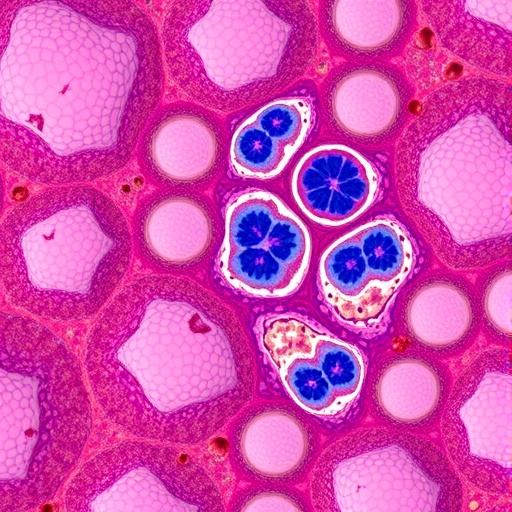Hepatocellular carcinoma (HCC) continues to be one of the most formidable cancer types worldwide, marked by its aggressive nature, high mortality rates, and limited therapeutic options. The relentless quest for reliable biomarkers that can improve early diagnosis and predict patient outcomes has driven researchers to adopt innovative, integrative approaches. A pioneering study published in BMC Cancer in 2025 sheds light on Nucleolar Protein 11 (NOL11), unveiling it as a novel prognostic biomarker for HCC through a comprehensive multi-omics analysis.
NOL11, traditionally understood as a vital component in ribosome biogenesis, plays a crucial role in the assembly of ribosomal subunits, a process indispensable for protein synthesis and cell survival. However, its implication in cancer biology, particularly in hepatocellular carcinoma, has remained largely unexplored until this recent investigation. Leveraging vast datasets from The Cancer Genome Atlas (TCGA) and the Gene Expression Omnibus (GEO), researchers meticulously evaluated NOL11’s expression patterns, discovering a significant upregulation in HCC tumor tissues as compared to normal liver counterparts.
Beyond mere expression levels, the research integrated cutting-edge spatial transcriptomics and single-cell sequencing technologies to map the precise temporal and spatial expression of NOL11 within the tumor microenvironment. This granular analysis revealed that NOL11 is predominantly overexpressed in malignant hepatocytes, underscoring its potential role in tumorigenesis and disease progression. Such spatial-temporal profiling provides valuable insights into how NOL11 may influence cellular heterogeneity and tumor dynamics at the microscopic level.
A detailed correlation analysis demonstrated that elevated NOL11 expression is tightly associated with adverse clinicopathological features, including advanced tumor stage, poor differentiation, and vascular invasion. These characteristics, collectively, delineate a more aggressive disease phenotype, translating into deteriorated clinical outcomes. The prognostic value of NOL11 was further corroborated by rigorous Cox regression analysis and ROC curve assessments, which confirmed its capability to predict overall survival and disease recurrence with impressive specificity and sensitivity.
One of the standout aspects of the study lies in the functional enrichment analyses performed to elucidate the biological pathways intertwined with NOL11 activity. Employing Kyoto Encyclopedia of Genes and Genomes (KEGG), Gene Ontology (GO), and Gene Set Enrichment Analysis (GSEA), the investigators unveiled that NOL11 is intricately involved in core oncogenic processes. These pathways encompass the cell cycle regulation, DNA replication fidelity, and metabolic reprogramming—hallmarks that are quintessential for sustaining uncontrollable cancer cell proliferation.
The tumor microenvironment’s immune landscape often dictates the therapeutic response and prognosis in HCC. In this context, NOL11’s relation to immune infiltration was probed using single-sample gene set enrichment analysis (ssGSEA). The findings suggest a robust correlation between elevated NOL11 levels and the infiltration of specific immune cell subsets, hinting at its possible modulatory role on the immune milieu within the liver cancer ecosystem. These interactions could have profound implications for immunotherapy strategies and patient stratification.
Beyond biological insight, the study integrates pharmacological relevance by exploring drug sensitivity patterns in relation to NOL11 expression. Utilizing integrated bioinformatics pipelines, researchers identified commonly used chemotherapeutic agents—including gemcitabine, trametinib, and paclitaxel—that exhibit enhanced efficacy in contexts of high NOL11 expression. Molecular docking studies augmented these findings by revealing strong binding affinities between these drugs and the NOL11 protein, suggesting a promising avenue for targeted therapies.
Importantly, the functional ramifications of NOL11 were not confined to computational models. The study incorporated in vitro experiments where silencing NOL11 expression in HCC cell lines resulted in marked suppression of cellular proliferation, migratory, and invasive capabilities. These phenotypic consequences are critical as they directly implicate NOL11 in the malignant behavior of hepatocellular carcinoma cells, potentially offering a therapeutic target to curb tumor progression.
The discovery of NOL11 as an independent biomarker paves the way for new diagnostic and prognostic tools that could be integrated into clinical workflows. Early detection and accurate prognosis remain pivotal in improving HCC patient survival, a goal that this research substantially advances by establishing NOL11’s utility in precision oncology. Moreover, this multi-omics approach acts as a blueprint for future studies aiming to dissect complex molecular interplays in cancer.
Therapeutically, the sensitivity of HCC cells with elevated NOL11 to established chemotherapeutics invites a re-examination of treatment modalities. Personalized medicine may benefit from incorporating NOL11 expression stratification to optimize drug selection and dosing. Furthermore, understanding NOL11-mediated signaling networks offers opportunities to develop novel targeted drugs that could synergize with existing regimens.
This integrative study exemplifies how combining large-scale genomics data with spatial transcriptomics, functional bioinformatics, and experimental validation can unravel novel molecular players in cancer. The insights gained not only enhance our comprehension of HCC biology but also highlight the expanding horizon of multi-disciplinary research approaches in combating complex diseases.
In summary, the identification of NOL11 as a robust prognostic biomarker, its association with immune infiltration, and its influence on drug responsiveness collectively underscore its significant clinical and biological relevance in HCC. This landmark research propels the field towards more effective and individualized interventions, ultimately aiming to mitigate the global burden of hepatocellular carcinoma.
As the scientific community continues to grapple with the challenge of HCC, studies like this underscore the transformative power of integrated multi-omics analyses. In harnessing these technologies, we inch closer to unraveling the molecular intricacies of tumors and translating them into tangible clinical benefits for patients worldwide.
Subject of Research: Hepatocellular carcinoma; Nucleolar Protein 11 (NOL11); prognostic biomarker discovery; multi-omics integrative analysis
Article Title: Integrated multi-omics analysis reveals NOL11 as a novel prognostic biomarker for hepatocellular carcinoma
Article References:
Li, Z., Fu, Y., Wei, Y. et al. Integrated multi-omics analysis reveals NOL11 as a novel prognostic biomarker for hepatocellular carcinoma. BMC Cancer 25, 1635 (2025). https://doi.org/10.1186/s12885-025-15113-9
Image Credits: Scienmag.com
DOI: https://doi.org/10.1186/s12885-025-15113-9
Tags: aggressive liver cancer researchcancer biomarkers discoveryearly diagnosis of liver cancerexpression patterns in HCCHepatocellular carcinoma prognosisinnovative cancer diagnostic approachesmulti-omics analysis in cancerNOL11 liver cancer biomarkerribosome biogenesis and cancersingle-cell sequencing technologyspatial transcriptomics in oncologytumor microenvironment analysis





